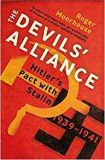The Devils' Alliance: Hitler's Pact with Stalin, 1939-1941 by Roger Moorhouse
| The Devils' Alliance: Hitler's Pact with Stalin, 1939-1941 by Roger Moorhouse | |
|
| |
| Category: History | |
| Reviewer: John Lloyd | |
| Summary: For fascinating detail, and a great redress of an under-explored facet of WWII, this book will be manna to many. But for the depth of the detail and the over-egged effort to correct the forgotten nature of the subject, it may just be too much. | |
| Buy? Maybe | Borrow? Yes |
| Pages: 400 | Date: January 2016 |
| Publisher: Vintage | |
| External links: Author's website | |
| ISBN: 9780099571896 | |
| Video:
| |
Before WWII started, you didn't really have peace. Tensions had hardly settled down since the Great War, and there had been conflicts several times since, particularly in what would become the Theatre of War in eastern Europe. Nazi Germany and the Soviet regime were already at loggerheads, with the former supporting Japanese aggression in eastern Asia. They were bedfellows in evil, but very much on opposing sides. But with things stirring like never before under Hitler's expansionist activities, and despite numerous instances of this side talking to that potential enemy about the other, Nazi and Communist seemed to be firm foes. Both had publicly been denouncing the other – the Soviets deeming Nazis one side of the same corrupt, capitalist coin as us Brits, the Hitlerites already equating Communism with Jewry. But from under that period when the sides were pouring buckets of shit on each other's heads (sorry for the language, but it’s me quoting Stalin, believe it or not) came an extraordinary Pact – one of a handful in fact, that deemed Germany and Russia non-aggressors and collaborators, - just in time for them to share Poland between themselves. The initial document was short, but had an impact to affect 50 million people then, and many millions now – and yet it's hardly been the subject of a full look before now.
And I mean full. I have to admit that very early on I could tell this book could tell me all I would ever need to know on the subject – but a heck of a lot more, besides. I had the distinct impression Moorhouse was trying to prove his the definitive study of the topic, agreeing with his own statement that it was desperately under-researched and far too little thought of, but going the wrong way, making the exhaustive the exhausting. It's there in all detail you could need, from the man on the Krakow omnibus up to the very highest diplomacy – what happened, who thought what, and what the consequences were.
I would be able to deem it an academic work of the highest level, perhaps, if it was structured better. But after concentrating on the unlikely formulation of the Pact and the way the two sides were able to divvy eastern Europe as the result of a very top secret addendum to it, the book reverts to two chapters of what the opinion and then the global response was. It then interrupts its own momentum once more by discussing the side issue of a trade pact that ran alongside the main one.
Incident throughout can be remarkable enough to get through the dryness, but it's certainly welcome when it does. Here are films removed from cinemas because they used to show the enemy in a bad light but now there's an easing in diplomacy so the propaganda has to be altered. The range of this book is nothing if not extraordinary – from Brecht's literary response, to the fact that Soviet ice-breakers led disguised German boats right across the Arctic to attack British targets in Pacific waters.
Here too is Britain trying to suggest to Stalin that he have a similar kind of deal with us, completely ignoring the fact that he had been firming up the ground immediately between him and his nearest enemy, and getting goods and materiel as a result. And anyway, it's highly likely both sides were trying to swindle the other, and getting only what they needed out of the Pact – which makes the history of its birth, existence and eventual disintegration a fascinating tale. But to me at least this had too much in it for the lay reader, and I would hazard a guess that I have read more books about this period than the average. Yes, the notes are copious for the student, and completely academic, meaning the regular audience member need never flick to them to disturb the flow, but the flow is too much like treacle at times. It's a superlative effort and really a distinguished book in that regard, but as general, populist reading I think it is too long and too often trying to redress the professorial shortfall the author speaks of.
I must still thank the publishers for my review copy.
Bloodlands: Europe between Hitler and Stalin by Timothy Snyder is the best book for covering this area of Europe, and detailing every carving-up of it the war caused.
Please share on: ![]() Facebook,
Facebook, ![]() Twitter and
Twitter and
![]() Instagram
Instagram
![]() You can read more book reviews or buy The Devils' Alliance: Hitler's Pact with Stalin, 1939-1941 by Roger Moorhouse at Amazon.co.uk Amazon currently charges £2.99 for standard delivery for orders under £20, over which delivery is free.
You can read more book reviews or buy The Devils' Alliance: Hitler's Pact with Stalin, 1939-1941 by Roger Moorhouse at Amazon.co.uk Amazon currently charges £2.99 for standard delivery for orders under £20, over which delivery is free.
![]() You can read more book reviews or buy The Devils' Alliance: Hitler's Pact with Stalin, 1939-1941 by Roger Moorhouse at Amazon.com.
You can read more book reviews or buy The Devils' Alliance: Hitler's Pact with Stalin, 1939-1941 by Roger Moorhouse at Amazon.com.
Comments
Like to comment on this review?
Just send us an email and we'll put the best up on the site.


